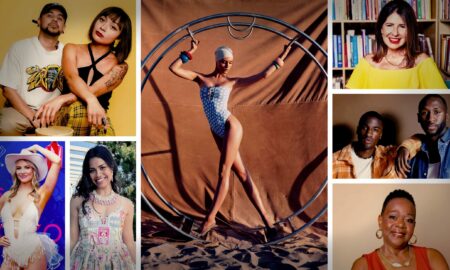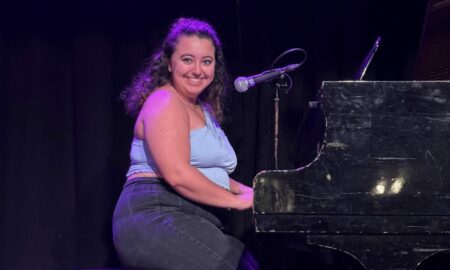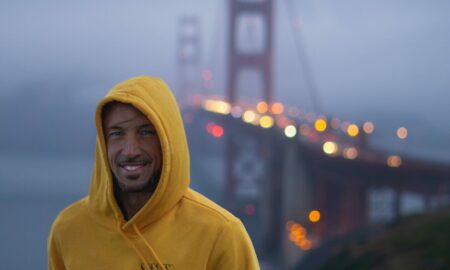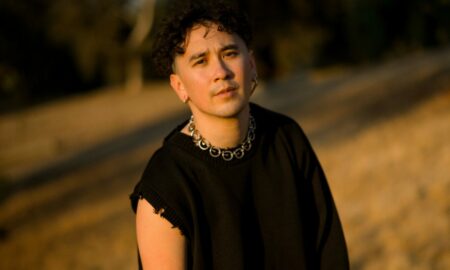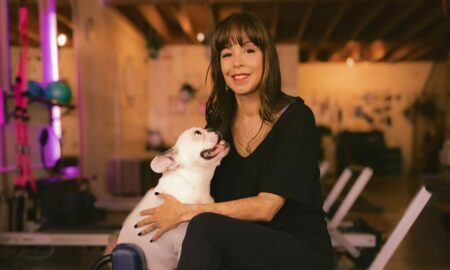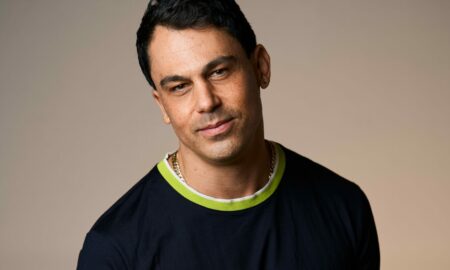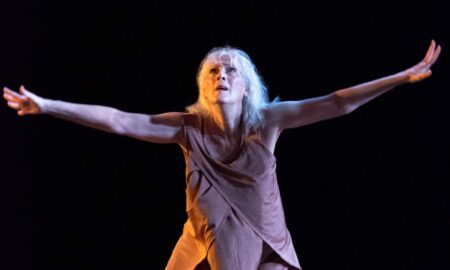

Today we’d like to introduce you to Gary Lett.
Gary, can you briefly walk us through your story – how you started and how you got to where you are today.
My first recollection of having artistic talent occurred before I entered grade school. It is still so vivid in my mind: I grabbed a sheet of one my siblings ruled school paper, a pencil, and pulled a chair up to a wall in my parents’ bedroom where my Dad had installed a mirror. I climbed on top of the chair, pressed the paper against the mirror and commenced to drawing a self-portrait.
Among my family and on through elementary to high school, I was recognized as the artist. Actually, that recognition has never stopped. To this day, when people from my old neighborhood hear that one of them, Lett, brothers is present, and when they inquired as to which one I was, they’d say, “oh you’re the artist!” And all I can reply is, “yes.” First, you must know that I come from a large family: seven boys and two girls, but back in the 40’s and 50’s that was much more commonplace in comparison to today’s family. Sequentially, I am the seventh child and the fifth son.
Within my family, I was not the first nor the only sibling with drawing ability. In my adolescence, I had no shame in clamming or taking credit for one of my older brother’s drawings. But, that didn’t last long, before we knew it, I was out drawing them all while in elementary school. In addition to my brother’s inspiration, during that time, there were two other persons that encouraged me. One being just a couple of years older than myself; LaMearl and the other was my eldest sister, Laveion’s, boyfriend; Douglas, who was not around long after being drafted into the military. Nevertheless, when he did visit, just like, LaMearl, I would have him draw dragsters too. For point of reference, I’m only around eight or nine years old.
The Winter National Drag racing was held and still course annually as a sporting event at the Pomona Fair grounds. The roaring of the engines are heard for miles in any direction. Those sounds had a mesmerizing effect on my artistic drive. It seems that during my formative years, all I wanted to draw were dragsters and the engines thereof. Vicariously, I attended the races through the drawings of my two friends and dragster magazines that I happen to come across. Drawing was my passion and I wanted to get better at it. Therefore, I would trace, but often I could not see fine details. So, out of nowhere, I devised a trancing technique by taping the subject matter to my bedroom window, and, presto, those dragsters popped through that drawing paper as if they were printed on the surface of it and not underneath! For quite some time thereafter, tracing became my new method of drawing. It wasn’t until I became a graphic artist at World Vision US that I came to know that my childhood window tracing technique had, now, become a marketable piece of office equipment designed for artists and photographers, known as a light-box.
The artist in me became dissatisfied with tracing: I needed a challenge! So, I abandoned my light-box technique and I began coping pictures freehand. I copied just about everything in sight. And by now, I could draw those dragsters and their engines from memory.
My sixth-grade teacher, Mrs. Fredricks, saw my passion for art, but she knew that if I was going to learn something other than art, she had to redirect my obsession. She gained control by forcing me and the entire class to illustrate picture books: a new curriculum instituted to force me to write. And I must say, it worked! I entered the sixth-grade book writing contest, and I won first place. Mrs. Fredricks pushed my artistic abilities beyond elementary art: she had me reproduce Vincent van Gogh, Sun Flowers. After it’s completion, she brought it to the Pomona Unified School District for an exhibition, and that was the last time I saw it. To this day, I wonder what happened to it. That was my first fine art painting, and it made an encouraging and lasting impression upon me in my ability as a true artist.!
Drawing superheroes along with the Rat Fink characters was fashionable in the seventh grade. And I drew them on the largest artboards that Fremont, Jr. High School had to offer.
After the seventh grade, culture shock shook my world: my family moved to the segregated South to my Father’s home town of Moss Point, Mississippi. Coming from the integrated West Coast and now living in an environment completely different from what I was used to, living there dampened my emotions and weighted them down on various fronts. Although I still drew, I lost the passion I once had, my drive dwindled. But, I acknowledge and give credit and thanks to my father’s youngest brother uncle, Don, for helping me find an additional talent that had been dormant until he helped awaken it: the ability to sign paint. Uncle, Don, was in a gospel group and he had me paint the name of it on the tail-end of their touring car. Little did I know that sign-painting would become an occupation for a ninth-grade student. Now that my uncle used my services, other family business owners called to employ me also! I now had become a little businessman.
After returning to my beloved Pomona, California, at the start of my Sophomore year, I was able to continue working at sign-painting around the city throughout my High school years. During my years at Garey Senior High School, I excelled in my art courses and was awarded a two-year art scholarship to Pepperdine University LA campus for the 1974 Fall session. And it was there that I had my first experience in clay. My art instructor taught both drawing and ceramics. I was his prize drawing student and he utilized my portraiture drawing skills during Pepperdine’s college recruitment day. One day he asks if I had ever worked in clay, and I replied “no!” He asks that I come to his ceramic class to learn about it, even though I was not enrolled. I personal believe, as a result of the three-dimensional qualities of my drawings, he was convinced that I would be a good sculptor. The day came he and he showed up with a female bust for me to copy. After showing me some technics of hollow hand-building, he let me loose. And to my surprise, I duplicated that sculpture to a tee! After it’s firing, together, we applied a patina. It was beautiful! It was the first sculpture that I gave to my mother, unfortunately, one of my nieces pushed it over and broke it. At the time, I knew nothing about ceramic repair, so in the trash it went. I made a few different kinds, after it, and I even sold one to my former High School principal, Mr. Tynes.
Unfortunately, I did not complete my two years at Pepperdine. My mother became ill and I returned home to assist with her care. Although I did continue my education at three different colleges. Even thou I enjoyed ceramics, I returned to my first artistic loves: drawing and painting.
I featured black life in the majority of my paintings. I was painting in both watercolor and oils. Most of the watercolors portrayed Southern Motifs. Whereas, the oils were vibrant like the painting of Frank Frazetta, and reflected various themes, from animals to landscapes.
In 1978, two events altered the directional course of my art-making: In 1976, I commemorated America’s bicentennial year with a graphite drawing that featured my grandmother and four of my elder siblings, in a 1950 photograph, where the youngest was three years old and the eldest nine. I copied that particular photo because it resonated with the emphasis of family unity and togetherness that I felt was the binding fiber of all-American life. I altered the photo, and in the drawing, I placed a bible under the free arm of my grandmother. Although I was born some six years later, I recall having to walk to church many Sundays, therefore, I wanted the viewers to experience something metaphorically of my personal life.
My girlfriend, Lisha, whom became Mrs. Gary V. Lett in 1979, helped finance the lithograph printing of that drawing and greeting cards of it.
It was 1978, and Lisha and I set-out to sell those prints and cards. I loved that drawing, and some individuals wanted to buy the original, but not at my asking price. I felt that as many people as possible should have a copy of it. So, I set out to make that happen, I sent a card to Hallmark greeting card company believing that, they too, would see the same value in it as I. Boy, how wrong was I! They replied that there was “NO market for Black subjects in the greeting card business”. I was crushed! But, Lisha and I didn’t let any grass grow under our feet, we continued to sale them until they ran out. Moreover, I must admit, Hallmarks rejection did put some doubt in my mind about my art.
The second experience that shocked my art world also occurred in 1978. I brought my watercolor paintings to an art gallery in LA, not far from the Heritage Gallery that featured and represented the art of my art Guru, Charles White. They too told me that there was market for what he termed “Black Art”. In hindsight, I should have disregarded both theirs and Hallmarks comments and stayed to coarse, because there was a major boom in the Black Art market a few years latter.
As a result, from that time forward, I vowed that my art would not be judged by the cultures shown within it, but rather, by all that went into the make it: look upon each piece for the sake of “expressions through art.” That ideology has stayed with me ever since the shocking statements about my art. I do not reference myself as a Black Artist, and I do not allow others to do so either, although I am a Black American. First and foremost: I am a man; second, I’m an American of African descent; and thirdly: my physicality within this swarthy skin is to be a maker of art.
There are times when I depict Blacks in my art, differing people groups, abstractions, basic forms and constructs, and traditional subjects.
My first career choice did not win out! The free wielding artist life that I first embarked upon turned into me having a regular nine to five, becoming a family man with a wife, two kids, dogs, attending church regularly, and working consistently as a graphic artist for over 20 years, although, I continued making art. I diversified and learned other art crafts and techniques that I would eventually parlay and employ as skills necessary in producing historical art products and projects that I do today.
In 2000, Lisha and I moved to San Antonio, Texas, and over my eight years there my art career expanded. In 2002, I reconstructed a cow and fashioned it into a two-headed life-size fiberglass cow that I turned into the first-responders working dogs: the Dalmatian of the fire department and the German Shepard of Police department. They were outfitted and fashioned with authentic-looking industry hats, sunglasses, and draped with the American flag they’re a superhero cape; In 2003, I built a full-size scaled-down replica of an 1800’s house using salvaged board donated by the city of San Antonio. It consisted of one bedroom, kitchenette, a small living room, kin roof, and it bolted together. The children in my After-School program replicated period artifacts in ceramic, papier-mache, copied historical paintings that featured landmarks around San Antonio during that time period and before, and drew life-size charcoal drawings on the bedroom walls (tableaux); In 2004, Also through my After-School art program, I erected a 24 feet x 14 feet ceramic tile mural that features 13 Texas-born musical legends. It is a noted city-wide tourist attraction.
Upon our return to California from San Antonio in 2008, it was tough starting over. If it had not been for my late mother, there is a good chance that Lisha and I would still be living there. Once back, I hit ground running to weave myself into a creative environment. It was at the end of 2010 that I embarked on a two-year goal to make twelve Biblical themed ceramic sculptures. And during that time, I managed a ceramic art studio where I was making the sculptures for my upcoming show. The show opened in December 2012 in a downtown Pomona art gallery.
Around 2014, I made my way to the American Museum Of Ceramic Art AMOCA. I was already acquainted with the studio manage there by way of the ceramic studio that I was managing, she would come and by supplies from us. She was very much aware of my work, and AMOCA had to fire a couple of my biblical sculptures of a series that I was working on because they were too large to fit into the kilns where I was managing. Heidi knew of my desire to teach sculpture and offered me a teaching opportunity, six years later, the COVID-19 Pandemic forced the closer of in-person teaching jobs. I am still affiliated with the museum where I hope to be accepted as one of its Board Members in 2021.
In 2016, I hired on at Foothill Country Day School to work with students and produce a special ceramic tile mural project that features 14 Nobel Laureates from around the world. The 16 feet 9-inch x 9 feet mural, that took three years to complete, is permanently attached to their gymnasium exterior wall.
In 2019, I was commissioned by the city of Monrovia to produce the third in a series of Neighborhood Treasure plaques. Mine honors Bettie May Scott, a WWII WASP who died during a test flight.
Currently, I maintain a studio at the Inland Conservatory For The Performing Arts in Ontario, CA. Where I resided as the Fine Arts Director/Instructor.
We’re always bombarded by how great it is to pursue your passion, etc – but we’ve spoken with enough people to know that it’s not always easy. Overall, would you say things have been easy for you?
My early childhood academic challenges plagued me, and for years to come!
Although my father was a WWII vet, he nor my mother emphasized education, in part, due to their lack thereof. I recognized early in life that I struggled with memorization of written language. There was a particular incident that haunted me for a long time: My mother was a scout leader and I wanted membership, and all was going well until it came time for me to memorize the Scout Oath. I recall my sister, Laveion, working with me in that regard and telling me that could not leave her bedroom until I could recite the Oath—Disappointingly —I don’t remember ever wearing a Scott uniform! But what I do member is thinking badly about myself, feeling like a failure, and thinking that I was a dummy for not having memorized the Oath.
Things for me got even worse! I was placed in Special Education my 5th and 6th grades. My parents did not keep track of my schooling. So little in fact, I could bring home my report cards and throw them into my closet on the top shelf, hiding them away. I do not remember ever being asked or scolded for not bringing them home. And I do not recall my parents coming to the school for a parent-teacher conference concerning my schooling. And If that did happen, I must have purged it from my mind. Sadly, I can’t ask, for they both are deceased.
Those Special Ed classes did not focus on the student’s academic needs, but rather provided pleasurable outlets like cooking, board games, etc. My 5th-grade teacher allowed me to control the paper cabinet: I positioned my desk in front of it and issued out the paper in the amount I wanted each student to have. I had to make sure that there was enough paper for me to do all the drawings that I wanted, and she allowed it.
It is well documented that a child’s formative years set the foundation for the remainder of their life. That one principle overlaps into various aspects of our life and affects us all at different stages. While in my teenage years told myself that I would always be a student. And true to that statement, I’m presently living it out! At age 64, I’m still working on my English and other academic skills. As an adult, I have noticed that when I couple art with history, for example, my retention of information increases substantially. Learning, apart from art, negatively affected my high school and college grades, resulting in making those educational years, overall, unenjoyable. It is something how, now, when I work on projects with a historical bend, I’m most anxious to work on them. I should’ve used my 6th-grade teacher’s learning principle into all of my academic classes.
My most overwhelming challenge has always been balancing family vs. professional life!
I always knew that I wanted to be a family man: a husband and father. And becoming a world-renown painter was the means by which I would obtain fame and fortune, so I thought, in order to support a family. But fate had other plans! While I was living in Lancaster, CA and attending Antelope Valley college, I met my future wife to be, Lisha, 18, but unbeknown to me, she was raising her six siblings, and she, being the eldest and the youngest was nine years old.
Unprecedented, the State Department of Children and Family allowed Lisha and her siblings to reside in a separate house apart from the guardian appointed by them. Lisha’s role was not only that of big Sis but, mother and father. You see, her stepfather that raised her from age two shot and killed their mother right before their eyes. Lisha had just tuned seventeen by one month. The father was incarcerated, but for a short period of time. He was locked-up when I met, Lisha.
At the time of our meeting, I was focused on my studies, working part-time at NASA’s Hugh L. Dryden Flight Research Center in Edwards, CA: the location of the Space Shuttle’s historic piggy-back flight a top the 747, and freelancing as an artist. Lisha and I were there for that historic flight. She worked as a secretarial assistant to the Director’s Administrator Assistant, and I worked with the engineers that did tests and some fabrication for the Shuttle.
At that time, my friendship with, Lisha, turned serious. My self-imposed restricted days to socialize with her became more frequent: two days became three, three became four, and before I knew it, we were with each other every day, especially during our summer months while working at NASA.
Like, Lisha, I now found myself in the role of surrogate father, big brother, friend, taxi, and in a committed relationship with her. Although I still had my sights on being a famous artist. Moreover, my concern for she and her sibling’s well-being became of utmost important to me and my immediate family.
The importance of family has always been a core value of mine. Being a single parent, from my High school years and onward, my mother always looked to me as her helper. Some of my siblings would refer to me as her husband because of my commitment around the house and picking-up her slack in certain areas, especially during her time’s illness. I found pleasure in walking to the Welfare location and pick-up the Food Stamps whenever she asked. So, Lisha’s situation came into my life at a time when I was available, suited, and equipped to be helpful, since I was not overly rooted or committed in my pursuit of an art career. My art focus was redirected!
Now it seems that more distractors soon followed: My mother suffered a heart attack. And it was I, out of my remaining seven siblings, to leave my part-time job at NASA, college, and Lancaster to care for her. While caring for my mother, I enrolled in a job training program that paid me to attend. I earned a Quality Control Inspection certification and landed a job upon graduation. I would fit art in when I could: late at night after all my chores. My art concentration, if you could call it that, was a continuation in watercolor, an interest I gained after meeting Dr. William Ko; Scientist, Mathematician, Inventor, and Watercolorist while working at NASA. Dr. Ko befriend me and even gave me his watercolor painting formula. It was through the selling of one of my watercolor paintings that I brought Lisha’s engagement ring. My Quality Control Inspection job was short-lived, and I returned back to college and working evenings and weekends at Churches Chicken. My mother had a full recovery from her heart attack and lived an additional thirty years.
Lisha and I married in 1979. Our plan was for me to continue working nights, therefore, I could attend Otis Art Institute. By now, I was working full-time at World Vision US. As a custodian, and Lisha was working as a Microfiche Clerk at Glendale Federal Savings in Burbank. I finally felt as if things were working out in my favor for getting a higher education in art since my professional painting career had faltered.
We got pregnant! Oh no! I was still determined to return back to school even with a new-born. But as fate would have it, Lisha became ill after the birth of Vincent and was placed on permanent disability. My hopes of returning back to school was shattered. All that I could concentrate on was Lisha’s, healing and being a father to new-born.
After a brief stay for Lisha’s two younger siblings with their murderous father’s family in Austin, Texas, they came to live with me, Lisha, Vincent, and by now, an infant son, Victor. At this time, I have moved into a graphics art position at World Vision US. My fine art career had come to a dribble, the only thing that I was doing with it was having periodic shows, displays, and contest with my sculptures. Together, we were managing a 22 unit apartment complex. Thankfully, Lisha was healthy enough to do that. With her help, my job at World Vision, and graphic art freelancing we were able to buy a house and move to my home town of Pomona. By now, Lisha’s sister, LaShon, and brother, Raymond, had graduated High School; he went into the Army and LaShon was working full-time for World Vision US.
RACISM
I was the type of parent that did not allow my work to dominate my children’s school activities or times that my wife needing caring after. All of my corporate America bosses knew that, therefore, I feel that I lost favor for some advancement because of it, coupled with the ills of racism. Some people might be able to have a platform in which to argue someone else’s handling of pulling-out the proverbial “Race Card” after being denied a promotion or being harassed, but not me. My personal experience with it is undeniable. While going through it the first time, I could not put a handle on what nor why I was feeling the way that I was, for I had never gone through anything that made me feel so uncomfortable and physically sick in any given work environment. Although I saw freelance graphic artists walking out of our office with work, I salivated over the opportunity to do, I felt helpless in voicing my frustration. My blood pressure elevated, and I was diagnosed with spastic colitis: both illnesses brought on my stress.
In order to remain on that job, I had to try something and try it fast. I mustered up enough courage to confront my boss about what I saw going on. I was taking back by how cool and relaxed he was when I explained that I wanted better jobs, jobs like those given to freelancers by my supervisor. And I got them! Remember, I mentioned the “Race Card” argument platform? I can stand my ground and state, emphatically, that my supervisor had employed belittling treatment and tactics on me because of my Black heritage when he denied me better jobs. Years after not having worked with him and now employed elsewhere, out of the blue, I received a phone call from him. He told me that he had just returned from a Christian men’s conference called Promise Keeper’s. It was big in the 90’s. He told me that he was spiritually convicted about his treatment towards me when we worked together and that it was racially motivated, and he apologized for it. My next full-time employment opportunity, unfortunately, implanted some of those same emotions and frustrations that I experienced with him. Although they were not due to undesirable work projects, but other circumstances.
That company’s leadership was very conservative and with the majority of the staff standing on the same platform. I, on the other hand, was different! I felt different, I looked different, and I lived in a different community than most of them: they lived in Orange county and me, LA county. During a time when I had seniority in its art department and being the only male black working for this company, I worked hard at fitting in, although there were some individuals that I genuinely clicked with and liked. I often had to rebuild my self-worth after being made to feel as if they did not want whites to be supervised by me, a black man. And If that was not the case, I would be the first to apologize for my miss judgment of them. But, they showed their hand when they hired a person with the task to reconfigure my department. And after that task was completed she was no longer around the company. That speaks volumes! Of my department, I had the most seniority and I was the only black. There was only three full-time staff personnel, and a freelance artist as the fourth: One was a female who had worked for the company a few years prior but in a different capacity, who had return back to college and earned a graphic arts degree, and who had only worked in the art department less than two years, and whose sister was the assistant to the company’s president; a male with the company for only two years; the freelancer; and me, the only ten-year.
What happened next is what sent me through the roof: The reorganized department was divided into two teams of two and with an appointed team leader. I knew for certain that I, the only ten-year and a full-time staff member with seniority would land a Team-lead position. But, to my horror and shock, I did not! The company let me down, they were real chickens! They brought a stranger into the company to do their dirty work for them: they had no accountability! After that, it was hard for my supervisor to look me in the face and me into his. But, I had to continue on: I had a mortgage, a sickly stay-at-home wife, a car note and other expenses, therefore, I had to keep working to sustain.
After eleven years and another racial incident, I couldn’t take it anymore, I quit the company.
My career from that point on has been based on the jobs that I want. My successes have been based on my physical strength to complete the task: I go after the jobs and projects that, first of all, I want to do. Second, those that I know that I can complete if awarded the contract.
My working philosophy is this: What is for me, is for me!
Please tell us more about your art.
When it comes to the word, work, in relation to what I do as an occupation, I throw that term around loosely. I’m in tune with my body and mind enough to know when it’s quitting time for the day when making art.
I, like every human, can only do as much as my body and mind will allow. I am more than impressed—I’m astonished—when I see individuals with half of a body walk across the county using it, and their arms to do so. I’ve often wondered, with what resolve and reservoir do they pull from in their attempt to tackle such a feat? I know for me before I start any project, I first see it completed in my minds-eye. Once I resolve that, It’s off to the races: all that want to do is bring the project to life.
I’m a multi-media artist: I love making art using clay, paint, drawing, wood, plaster, computers, etc. Because I have learned the capability of various materials, I enjoy trying different things.
Producing ceramic tile murals is an art form that I really enjoy doing. I especially like conceptualizing the idea along with the research necessary for the project; designing; production; glazing realistic portraitures and images; and the installation thereof.
Ceramic sculpting has become my second love in art-making.
I have two monumental custom ceramic tile murals that are my crowing jewels; one is in San Antonio, Texas, that features Texas-born Musical legends that measure 24 ft x 14 ft and is a tourist attraction. The second is in Claremont, CA at Foothill Country Day School that features international Nobel Laureates it measures 16 ft 6inc x 9 ft.
I’ve been told that no matter the art piece I make, it reveals that my hands were on it. In all my art-making, I work to satisfy myself first. If it is a commission, I have my client’s vision at the forefront of my mind with the intent of marching their vision. But even in that, I first must satisfy my critical eye of observation for detail and accuracy.
I believe in purpose, fate, and fortune! Each person’s destiny is filled with recourse. We must learn to accept the bitter with the sweet; the pit with each Cherry. I measure success not by lucky chance, but by the effort put in, and that which materializes is the fate of life. And fortune for me at the end of the day is measure by the joy in my heart.
Has luck played a meaningful role in your life and business?
First, I do not believe in luck. All things have reason and purpose. I would say that there is good fortune and not so good fortune, there is bitter and there is sweet, there are hard times and there are easier times. All in all, I learn from each phase of life I find myself. I even learn from other’s experiences: the does and don’ts!
I have a good life. Could I benefit from have more monetary resources, my all means, yes! What I have obtained in life and business is a direct result of my destiny and purpose in real-time of each moment given. No luck involved what so ever. My footsteps are ordered by The Most High.
Contact Info:
- Phone: 9094558659
- Email: [email protected]
- Instagram: letts_do_art
- Facebook: Gary V. Lett











Image Credit:
Top left: International Peace Mural, 2019; Top Right & 3rd left: The House That Ella Built, 2003; 4th right: Installation of International Peace Mural, 2019; 5th left: Texas-born Musical legend Mural, 2004; 6th right: Gary with his sculptures 7th, 2019; left: Gabriel, watercolor 1978; 8th right: Unsung Heroes, fiberglass 2002; 9th left: Positive Roots, graphite 1976; 10th Right: Baby Gots My Back, ceramic 2006; 11th bottom; Blessed vs. Judgement 2010
Suggest a story: VoyageLA is built on recommendations from the community; it’s how we uncover hidden gems, so if you or someone you know deserves recognition please let us know here.

